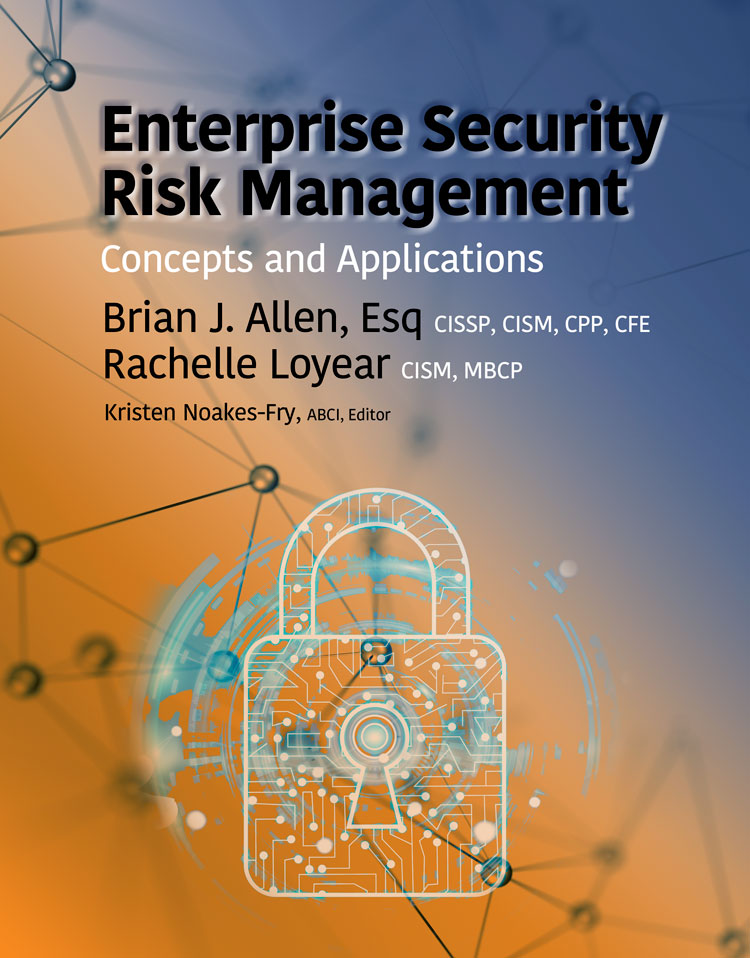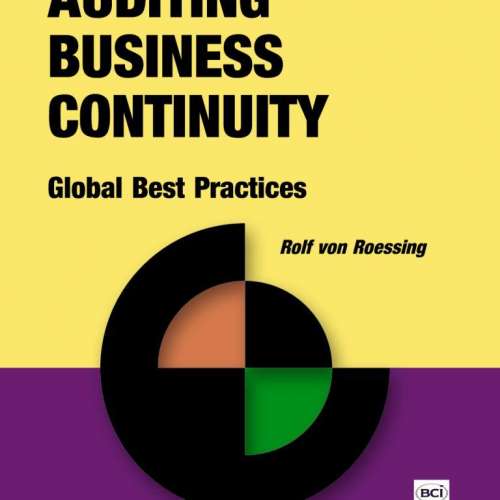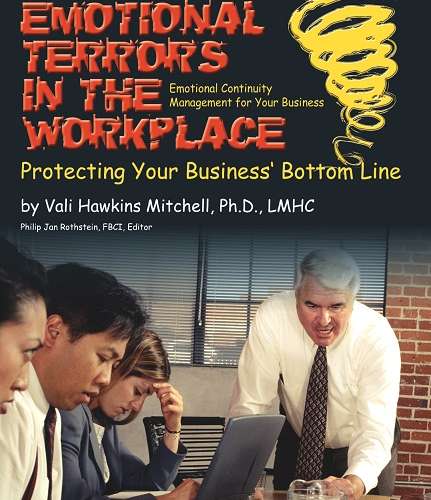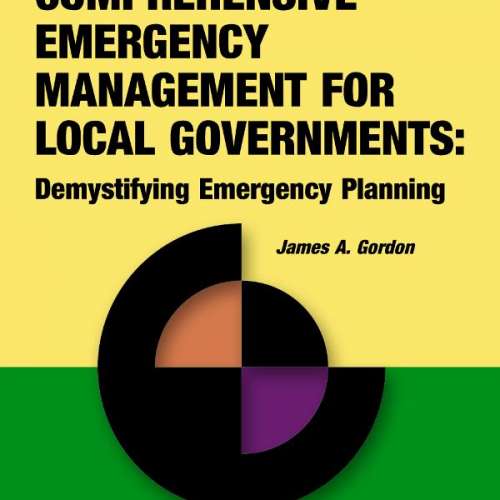Contents
COPYRIGHT. 2
Dedication. 3
Acknowledgments. 3
Foreword. 5
Foreword. 7
Foreword. 9
Part 1: Why Enterprise Security Risk Management (ESRM)?. 25
1: What is Enterprise Security Risk Management?. 28
1.1 ESRM Defined. 29
1.1.1 Enterprise. 29
1.1.2 Security Risk. 29
1.1.3 Risk Principles. 29
1.2 ESRM Overview.. 30
1.2.1 ESRM Mission and Goals. 30
1.2.2 ESRM Life Cycle – A Quick Look. 31
1.2.3 Your Role in ESRM… 31
1.3 Why is ESRM Important?. 32
1.3.1 Traditional Corporate Security Scenarios: Something is Missing. 34
1.3.2 ESRM as a Driver for Consistency. 34
1.4 What is ESRM Not?. 36
1.4.1 How is ESRM Different from Enterprise Risk Management (ERM)?. 36
Questions for Discussion. 40
References. 41
Learn More About It 41
2: How Can ESRM Help You?. 42
2.1 Security Function Professionals. 43
2.1.1 The Student 43
2.1.1.1 How Can ESRM Help You?. 43
2.1.2 The New Security Practitioner 44
2.1.2.1 How Can ESRM Help You?. 44
2.1.3 The Security Manager or Executive. 44
2.1.3.1 How Can ESRM Help You?. 44
2.1.4 The Transitioning Public Sector Professional 45
2.1.4.1 How Can ESRM Help You?. 45
2.2 Business Functional Professionals. 46
2.2.1 The Business Function Manager 46
2.2.1.1 How Can ESRM Help You?. 46
2.2.2 The Senior Executive. 47
2.2.2.1 How Can ESRM Help Your Organization?. 47
2.2.3 The Company Board of Directors. 47
2.2.3.1 How Can ESRM Help Your Organization?. 47
Questions for Discussion. 50
References. 51
3: How Can ESRM Help Your Security Program?. 52
3.1 The Traditional View of Security and Why the Industry Must Change. 53
3.1.1 The Traditional View of Security. 53
3.1.1.1 What Does Security Do? – The Answer from the Security Practitioner 53
3.1.1.2 What Does Security Do? – The Answer from the Board of Directors and Senior Executives. 54
3.1.2 Why the Security Industry Needs to Define “Security”. 54
3.1.3 The ESRM View of Security – A Profession, not a Trade. 55
3.1.3.1. Managing Security Risks. 56
3.1.4 ESRM-Based Security – Moving from Task Management to Risk Management 56
3.1.4.1 Security Task Management 56
3.1.4.2 Security Risk Management 57
3.1.4.3 The ESRM Solution: A New Philosophy. 57
3.1.5 Why Is the Traditional Approach to Security So Frustrating for So Many People?. 57
3.1.5.1 The Missing Network Switch: A Story of Security Frustration. 58
3.1.5.1.1 The Traditional Security Environment 58
3.1.5.1.2 The ESRM Security Environment 60
3.1.5.1.3 The ESRM Difference. 60
3.2 The Evolving Global Risk Environment is Driving Industry to Risk Management Postures. 61
3.2.1 Security and Risk Threats are Real 61
3.2.2 The Risk Conversation is Changing Rapidly. 62
3.3 What Does “Security Success” Look Like?. 63
3.3.1 Success is Not Just Measured by Numbers. 63
3.3.2 In Security Success, Intangibles are Important 63
3.3.3 Your Answers Create Your Definition of “Success”. 64
3.3.4 The Security Professional and the Business Leader: Using ESRM to Move Beyond Frustration to Success. 65
3.3.5 The ESRM Philosophy of Security Success. 65
3.3.5.1 Security Becomes Strategic. 66
3.3.5.2 Security Becomes a Business Function. 67
Questions for Discussion. 69
References. 70
Learn More About It 70
Part 2: The Fundamentals of ESRM… 72
4: Preparing for an ESRM Program.. 74
4.1 Understand the Business and its Mission. 75
4.1.1 Holistic Understanding of Risk. 75
4.1.2 The Needs of Your Business. 77
4.1.3 Sources of Information. 78
4.1.3.1 Company Insiders. 78
4.1.3.2 Company Published Communications. 79
4.1.3.3 Outsiders and The Media. 80
4.1.3.4 Observing Non-Verbal Communication – The Underlying Culture. 80
4.2 Understand the Business Environment 82
4.2.1 Examining the Environment the Business Operates In. 83
4.3 Understand Your Stakeholders. 85
4.3.1 What is a Stakeholder?. 85
4.3.1.1 Finding Your Stakeholders: A Closer Look. 86
4.3.2 Why Stakeholders Matter 87
4.3.2.1 Risk Stakeholder Conflict 88
Questions for Discussion. 91
References. 92
Learn More About It 92
5: The ESRM Cycle – An Overview.. 94
5.1 What is ESRM? – A Closer Look. 95
5.1.1 Similarities to Industry Life Cycles. 96
5.1.2 Application of the ESRM Model 98
5.2 The ESRM Life Cycle Model in Action. 99
5.2.1 A Task Management Approach. 99
5.2.2 An ESRM Approach. 99
5.3 ESRM is Cyclical, But Not Always Sequential 101
Questions for Discussion. 105
References. 106
6: The ESRM Cycle – Step 1: Identify and Prioritize Assets. 108
6.1 Step 1 – Identify and Prioritize Assets. 109
6.2 What is an Asset?. 109
6.2.1 How Do You Identify Business Assets?. 110
6.2.1.1 Finding Tangible Assets. 110
6.2.1.2 Finding Intangible Assets. 111
6.2.2 Who Really “Owns” an Asset?. 112
6.2.2.1 A Building. 112
6.2.2.2 A Server 113
6.2.2.3 The Web of Assets and Asset Owners/Stakeholders. 114
6.3 How Do You Assign Value to Assets?. 115
6.3.1 Simple Tangible Asset Valuation (Two Methods) 115
6.3.2 Complex Tangible Asset Valuation. 115
6.3.3 Intangible Asset Valuation (Three Methods) 116
6.3.4 Business Impact Analysis (BIA) 118
6.4 How Do You Prioritize Assets for Protection?. 118
6.5 How Do You Deal with Conflicts in Asset Valuation and Prioritization?. 119
Questions for Discussion. 121
References. 122
Learn More About It 122
7: The ESRM Cycle – Step 2: Identify and Prioritize Security Risks. 124
7.1 Identify and Prioritize Security Risks. 125
7.2 What is Risk?. 125
7.2.1 The Risk Triangle. 126
7.3 The Risk Assessment Process. 127
7.3.1 ISO Standard and Good Practices. 127
7.3.1.1 The ESRM Difference. 127
7.4 Risk Identification – Finding all the Risks. 128
7.5 Prioritizing Risks for Mitigation. 129
7.5.1 Presenting a Risk Matrix. 129
7.5.1.1 Education vs. Fear 130
7.5.1.2 Building a Matrix. 130
7.5.1.3 Building a Heat Map. 132
7.5.1.4 Security Risk Decision-Making. 132
7.5.2 Conflicts in Risk Prioritization. 133
7.5.2.1 The Role of Security. 134
7.5.2.2 The Role of the Asset Owner 136
Questions for Discussion. 139
References. 140
Learn More About It 140
8: The ESRM Cycle – Step 3: Mitigate Prioritized Risks. 142
8.1 Mitigate Prioritized Risks. 143
8.2 Risk Management and Mitigation Responses in Existing Industry Standards. 144
8.2.1 The ISO Risk Management Standard. 146
8.2.2 The ESRM Difference. 146
8.3 Risk Treatment Options. 147
8.4 Risk Mitigation Decisions. 147
8.4.1 Conflicts in Risk Mitigation Decisions. 148
Questions for Discussion. 151
Learn More About It 152
9: The ESRM Cycle – Step 4: Improve and Advance. 154
9.1 Improve and Advance. 155
9.2 Incident Response. 155
9.3 ESRM Investigations and Root Cause Analysis. 157
9.3.1 Performing a Root Cause Analysis. 158
9.4 Ongoing Security Risk Assessment 159
9.4.1 Sources of Risk Awareness. 160
9.4.2 Reporting and Employee Vigilance. 161
Questions for Discussion. 163
References. 164
Learn More About It 164
Part 3: Designing a Program That Works for Your Enterprise. 166
10: Designing an ESRM Program to Fit Your Enterprise. 168
10.1 Design Thinking – A Conceptual Model for Your ESRM Program.. 169
10.2 The Phases of Design Thinking. 170
10.2.1 Empathize Phase. 170
10.2.2 Define Phase. 171
10.2.3 Ideate Phase. 171
10.2.4 Prototype Phase. 172
10.2.5 Test Phase. 172
10.3 ESRM Program Rollout in a Formal Design Thinking Model 172
10.3.1 Educate and Involve the Stakeholders (Empathy) 173
10.3.2 Iterate the Process (Your Definition and Prototypes) 175
10.3.3 Mature the Process (Testing and Feedback) 176
10.3.4 Expand the Process (Begin Again with a Larger Scope) 177
Questions for Discussion. 179
References. 180
Learn More About It 180
11: Rolling Out Your ESRM Program.. 182
11.1 Rolling out ESRM in the Real World – A Story. 183
11.1.1 Step 1: Understanding the Current Environment and the Current Challenges (Empathy with Our Security Team) 183
11.1.1.1 A Deeper Dive (Even More Empathy) 184
11.1.2 Step 2: Communicating with the Business and Other Stakeholders (Empathy with Our Strategic Partners) 186
11.1.3 Step 3: Creating a Roadmap for the Program Rollout (Ideation and Brainstorming) 187
11.1.4 Step 4: Piloting the Program (Prototyping and Feedback) 188
11.1.5 Step 5: Implementation and Evolution Across the Enterprise. 190
11.2 ESRM Program Rollout Checklist 190
Questions for Discussion. 195
Learn More About It 196
Part 4: Making ESRM Work for Your Organization. 198
12: ESRM Essentials for Success. 200
12.1 Transparency. 201
12.1.1 Risk Transparency. 201
12.1.2 Process Transparency. 202
12.2 Independence. 204
12.3 Authority. 207
12.4 Scope. 208
12.5 Parallels with Other Risk-Based Functions. 210
12.5.1 What Are Audit, Legal, and Compliance?. 210
12.5.2 What do Legal, Audit and Compliance Functions Need for Success?. 211
Questions for Discussion. 214
References. 215
Learn More About It 215
13: Security Governance. 218
13.1 What is Corporate Governance?. 219
13.1.1 Defining Corporate Governance. 219
13.1.2 Why is Corporate Governance Important?. 219
13.1.3 Common Themes in Corporate Governance. 220
13.2 The Security Council: ESRM Governance. 223
13.2.1 Who is the ESRM Security Council?. 224
13.2.2 The Security Council’s Role in ESRM… 224
13.2.3 Setting Up a Security Council 224
13.2.3.1 Step 1: Define the Council Structure that Will Best Serve Enterprise Needs. 225
13.2.3.2 Step 2: Define the Security Council Stakeholders. 226
13.2.3.3 Step 3: Define the Mission, Objectives, and Goals of the Security Council and Document Them in a Council Charter 227
13.2.3.4 Step 4: Define Measurements/Project Key Performance Indicators (KPIs) for ESRM… 227
13.2.3.5 Step 5: Develop a List of Potential Quick “Wins” for the ESRM Program.. 227
13.2.3.6 Step 6: Begin the Process of Meeting, Reviewing, and Directing the Program According to the Council Charter. 227
13.2.4 Security’s Role on the Security Council: What It Is and What It Is Not 228
Questions for Discussion. 232
References. 233
Learn More About It 234
14: The Security Organization. 236
14.1 Where Should Security Report in an Organization Structure?. 237
14.1.1 Determining the Optimal Security Organization Reporting Lines. 238
14.1.1.1 Question 1 – What Does Security Need to be Successful?. 238
14.1.1.2 Question 2 – Which Lines of Reporting Carry Obvious Conflicts?. 238
14.1.1.3 Question 3 – What Reporting Structures are Available in This Enterprise?. 238
14.2 The Greatest Success Comes with the Greatest Independence. 239
14.3 Security Organization Internal Structure. 240
14.3.1 Defining Strategic Leadership Roles. 241
14.3.1.1 Aligning Tactical Skillsets with Strategic Management 242
14.3.1.2 Transitioning Yourself from a Tactical Practitioner to a Strategic Leader 243
Questions for Discussion. 245
Learn More About It 246
Part 5: An ESRM Approach to Tactical Security Disciplines. 248
15: ESRM and Investigations. 250
15.1 How does the Investigations Discipline Fit in the ESRM Life Cycle?. 251
15.2 An Investigation is an Incident Response. 252
15.3 An Investigation is the Source of Root Cause Analysis. 253
15.3.1 Identifying Root Causes Through Security Investigations. 254
15.3.1.1 Preparing for a Risk-Based Investigation. 254
15.3.1.2 During an ESRM Investigation. 255
15.3.2 Reporting Root Causes After a Security Investigation. 257
15.4 Investigations Drive Ongoing Risk Assessment 257
15.4.1 Postmortem Reporting and Responsibilities. 258
15.4.1.1 Security Role and Responsibilities. 258
15.4.1.2 Strategic Partner Role and Responsibilities. 259
15.5 A Deeper Look at the Role of Investigations in ESRM… 259
15.5.1 Comparing Traditional and ESRM Investigations. 259
15.5.1.1 One Successful Outcome. 261
15.5.1.2 All Successful Outcomes May Not Look the Same. 261
15.5.2 The ESRM Difference. 262
15.5.2.1 A Difference in Focus: Fact-Finding Versus Risk Identification. 262
15.5.2.2 A Difference in Goals – Accountability versus Risk Mitigation. 263
Questions for Discussion. 267
Learn More About It 268
16: ESRM and Physical Security. 270
16.1 How does the Physical Security Discipline Fit in the ESRM Life Cycle?. 271
16.2 Physical Security Activities Help Identify and Prioritize Assets. 271
16.3 Physical Security Activities Help to Identify and Prioritize Risks. 273
16.4 Physical Security Activities Serve to Mitigate Prioritized Risks. 274
16.4.1 Turning a Task into a Security Risk Mitigation Activity. 275
16.5 Physical Security Provides First Line Incident Response. 276
16.6 Physical Security Provides Input to Ongoing Risk Assessment 277
16.7 A Deeper Look at the Role of Physical Security in ESRM… 278
16.7.1 Comparing Traditional and ESRM Physical Security Methods. 278
16.7.1.1 One Successful Outcome. 280
16.7.1.2 All Successful Outcomes May Not Look the Same. 280
16.7.2 The ESRM Difference. 281
16.7.2.1 A Difference in Perception. 281
16.7.2.2 A Difference in Approach: Risk Management as a Positive Practice. 281
Questions for Discussion. 285
Learn More About It 286
17: ESRM and Cybersecurity and Information Security. 288
17.1 How does Cyber and Information Security Fit in the ESRM Life Cycle?. 289
17.1.1 The ESRM Cycle and the NIST Cybersecurity Framework. 289
17.1.1.1 Identify. 290
17.1.1.2 Protect 291
17.1.1.3 Detect 291
17.1.1.4 Respond. 292
17.1.1.5 Recover 292
17.2 Identifying and Prioritizing Assets in the Cyber Environment 292
17.3 Identifying and Prioritizing Risks in the Cyber Environment. 294
17.3.1 Risk in Cyber and Information Security. 294
17.4 Mitigate Prioritized Risks. 295
17.4.1. Risk Mitigation Planning: The Cybersecurity Framework. 296
17.4.1.1. Performing a Gap Analysis for Risk Mitigation Planning. 296
17.5 Improve and Advance. 298
17.5.1 Using the NIST Framework to Improve and Advance. 298
17.6 A Deeper Look at the Role of Cyber and Information Security in ESRM… 299
17.6.1. Operational Technology – More than Just Data. 300
Questions for Discussion. 304
References. 305
Learn More About It 305
18: ESRM and Workplace Violence and Threat Management 306
18.1 How does Workplace Violence Prevention and Threat Management Fit in the ESRM Life Cycle?. 307
18.2 Identifying and Prioritizing Assets in Workplace Violence Prevention and Threat Management Programs. 308
18.2.1 Asset Owners and Stakeholders: Everyone Owns Workplace Violence Prevention, Not Just Security. 309
18.3 Identifying and Prioritizing Risks in Workplace Violence Prevention and Threat Management Programs. 311
18.4 Mitigate Prioritized Risks Through Workplace Violence Prevention and Threat Management Program Design. 312
18.5 Incident Response in Workplace Violence Prevention and Threat Management Programs. 314
18.6 Root Cause Analysis in Workplace Violence Prevention and Threat Management Programs. 315
18.7 Ongoing Risk Assessment in Workplace Violence Prevention and Threat Management Programs. 316
18.8 A Deeper Look at the Role of Workplace Violence Prevention and Threat Management in ESRM… 318
18.8.1 A Difference in Focus: Holistic Workplace Violence Prevention and Threat Management Programs vs. Workplace Violence Response Training. 318
18.8.2 A Difference in Culture – Workplace Violence Awareness. 320
Questions for Discussion. 324
References. 325
19: ESRM and Business Continuity and Crisis Management 327
19.1 How does Business Continuity and Crisis Management Fit in the ESRM Life Cycle?. 328
19.2 Identifying and Prioritizing Assets and Risks in a Business Continuity and Crisis Management Program.. 329
19.3 Mitigating Prioritized Risks in a Business Continuity and Crisis Management Program.. 331
19.4 Incident Response in a Business Continuity and Crisis Management Program.. 332
19.5 Root Cause Analysis in a Business Continuity and Crisis Management Program.. 333
19.6 Ongoing Risk Assessment in a Business Continuity and Crisis Management Program.. 333
19.7 A Deeper Look at the Role of Business Continuity and Crisis Management in ESRM… 334
19.7.1 A Difference in Authority – Getting Traction. 335
19.7.2 A Difference in Transparency – Driving Acceptance Through Simplification. 335
19.7.3 A Difference in Independence – Ensuring Participation Through an Overarching Program.. 336
19.7.4 A Difference in Scope – Leveraging Resources for Success. 336
Questions for Discussion. 340
References. 341
Learn More About It 341
Part 6: ESRM Program Performance and Evaluation. 343
20: ESRM for Business Executives and Boards of Directors. 345
20.1 What do the executives need to know about ESRM?. 346
20.1.1 Point 1 for Executives – Understand What ESRM is and the Value of Implementing ESRM Within the Organization 346
20.1.2 Point 2 for Executives – Understand the Underlying Philosophy of ESRM and the Role of Security. 346
20.1.3 Point 3 for Executives – Essential Requirements for Security Success To communicate the basics of the ESRM philosophy, you will need to make sure your executives have a good understanding of the essential foundational elements of a successful ESRM program, which are: 347
20.1.3.1 Transparency. 348
20.1.3.2 Independence. 348
20.1.3.3 Authority. 348
20.1.3.4 Scope. 348
20.1.4 Point 4 for Executives – Understand ESRM Parallels with Other Risk-Based Functions. 349
20.1.5 Tailoring the Conversation. 349
20.2 What is the Role of Executives in an ESRM Program?. 352
20.2.1 The Executive Role of Ensuring a Definition of Security Success. 352
20.2.2 The Executive Role of Ensuring the Correct Security Skillsets. 353
20.2.3 The Executive Role of Ensuring the Essentials for Success are in Place. 355
20.2.4 The Executive Role of Ensuring the Correct Reporting Structure. 355
20.2.5 The Executive Role of Ensuring that the Board or Enterprise Ownership is Aware of the Role of Security and of Security Risks as a Business-Critical Topic. 356
20.3 What Should Executives and Boards of Directors Expect From ESRM?. 357
20.3.1 Reporting and Metrics. 357
20.3.2 Transparency of Risk. 357
20.3.3 Communications, Notifications, and Awareness. 358
Questions for Discussion. 360
References. 361
Learn More About It 361
21: Security Budgeting Process. 363
21.1 How has Security Budgeting been Approached Before?. 364
21.1.1 Fear, Uncertainty, Doubt – The FUD Factor 364
21.1.2 Making the Best of What You are Given, and the “Blame Game”. 365
21.1.3 Return on Security Investment 367
21.1.3.1 Return on (Non-Security) Investment 367
21.1.3.2 Whose “Return” is It?. 368
21.2 The ESRM Approach to Security Budgeting. 368
21.2.1 Value Chain Theory. 369
21.2.1.1 Increasing Value to your Primary Function Strategic Partners. 370
21.2.1.2 Is Security a Support or Primary Activity?. 372
21.3 Changing from a Traditional Security Budget to an ESRM Budget 373
21.3.1 Discover Existing Security Tasks and Activities. 373
21.3.2 Personnel Discovery. 374
21.3.3 Financial Discovery. 374
21.3.4 Building the Unified Budget 376
21.4 Ongoing/Annual Budgeting. 376
21.4.1 Budget Updates. 376
21.4.2 Budget Decision Making and Risk Tolerance. 377
21.5 Procurement Partnerships and the Role of Procurement in the Budget Process. 377
Questions for Discussion. 380
References. 381
Learn More About It 381
22: Reporting and Metrics That Matter 383
22.1 Why are Security Metrics Important?. 384
22.2 What is the Traditional View of Security Metrics Reporting?. 385
22.3 What is the ESRM View of Security Metrics Reporting?. 386
22.3.1 Metrics of Risk Tolerance. 387
22.3.1.1 Metrics of Risk Tolerance for Security Disciplines. 388
22.3.2 Metrics of Security Efficiency. 388
22.3.3 Comparing ESRM and Traditional Security Reporting. 390
22.4 Building Metrics Reports. 392
22.4.1 Communicating to an Executive Audience. 392
22.4.1.1 Planning a Security Report for Executives. 392
22.4.1.2 Building a Security Report for Executives. 393
22.4.2 Communicating to the Security Council Audience. 393
22.4.2.1 Planning a Security Report for the Security Council 393
22.4.2.2 Building a Security Report for the Security Council 394
22.4.3 Communicating to a Strategic Partner Audience. 394
22.4.3.1 Planning a Security Report for Strategic Partners. 394
22.4.3.2 Building a Security Report for Strategic Partners. 395
22.4.4 Communicating to Security Functional Leadership. 395
22.4.4.1 Planning a Security Report for Security Management 395
22.4.4.2 Building a Security Report for Security Management 396
Questions for Discussion. 398
Learn More About It 399
23: ESRM and the Path to Security Convergence. 401
23.1 The Common View of Security Convergence. 402
23.1.1 Technological Convergence. 402
23.1.2 Organization Convergence. 403
23.2 The ESRM View of Security Convergence. 404
23.2.1 Convergence of Philosophy. 404
23.3 Why ESRM Often Leads to Converged Organizations. 405
23.3.1 Changed Understanding of Roles Leads to Changed Structures. 405
23.3.2 Changed Understanding of Risks Leads to Changed Structures. 406
23.3.3 Changed Understanding of Practices Leads to Changed Structures. 406
23.3.4 The Convergence Decision. 407
23.4 The Benefits of a Converged Organization in an ESRM Security Program.. 407
23.4.1 The Converged Security Team Aligns All Security with the Enterprise Business Mission. 407
23.4.2 The Converged Security Team Helps Change the Perception of Security. 408
23.4.3 A Converged Security Program Unifies Security Awareness Efforts. 408
23.4.4 A Converged Security Program Reduces Employee Confusion. 408
23.4.5 A Converged Security Program Promotes Efficiency of Security Operations. 409
23.4.6 A Converged Security Program Optimizes the Risk Profile. 410
23.5 The Challenges of Converging an Organization in an ESRM Security Program.. 411
23.5.1 The “Culture” Challenge. 411
23.5.2 The “Control” Challenge. 412
23.5.3 The “Different Tasks” Challenge. 413
23.6 Executive Leadership of a Converged Organization in an ESRM Environment 414
23.6.1 CSO Requirements in a Converged ESRM Organization. 414
23.7 If Your Enterprise Chooses to Converge. 415
Questions for Discussion. 417
References. 418
Learn More About It 418
Credits. 419
About the Authors. 421


 virtually every aspect of the security field. He most recently held the position of Chief Security Officer (CSO) with Time Warner Cable (TWC), a leading multinational provider of telecommunications, information, and entertainment services headquartered in New York City. In this role, he was responsible for protecting TWC’s assets worldwide, coordinating the company’s crisis management and business continuity management (BCM) programs, managing TWC’s cybersecurity policy and leading its security risk management program. He managed the company’s security policy and relations with law enforcement and government authorities, as well as all customer security risk issues, oversaw internal and external investigations, and headed the company’s workplace violence program.
virtually every aspect of the security field. He most recently held the position of Chief Security Officer (CSO) with Time Warner Cable (TWC), a leading multinational provider of telecommunications, information, and entertainment services headquartered in New York City. In this role, he was responsible for protecting TWC’s assets worldwide, coordinating the company’s crisis management and business continuity management (BCM) programs, managing TWC’s cybersecurity policy and leading its security risk management program. He managed the company’s security policy and relations with law enforcement and government authorities, as well as all customer security risk issues, oversaw internal and external investigations, and headed the company’s workplace violence program. managing various projects and programs in corporate security organizations, focusing strongly on business continuity and organizational resilience. In her work life, she has directed teams responsible for ensuring resilience in the face of many different types of security risks, both physical and logical. Her responsibilities have included: Security/BCM program design and development; crisis management and emergency response planning; functional and location-based recovery and continuity planning; crisis management and continuity training and operational continuity
managing various projects and programs in corporate security organizations, focusing strongly on business continuity and organizational resilience. In her work life, she has directed teams responsible for ensuring resilience in the face of many different types of security risks, both physical and logical. Her responsibilities have included: Security/BCM program design and development; crisis management and emergency response planning; functional and location-based recovery and continuity planning; crisis management and continuity training and operational continuity

